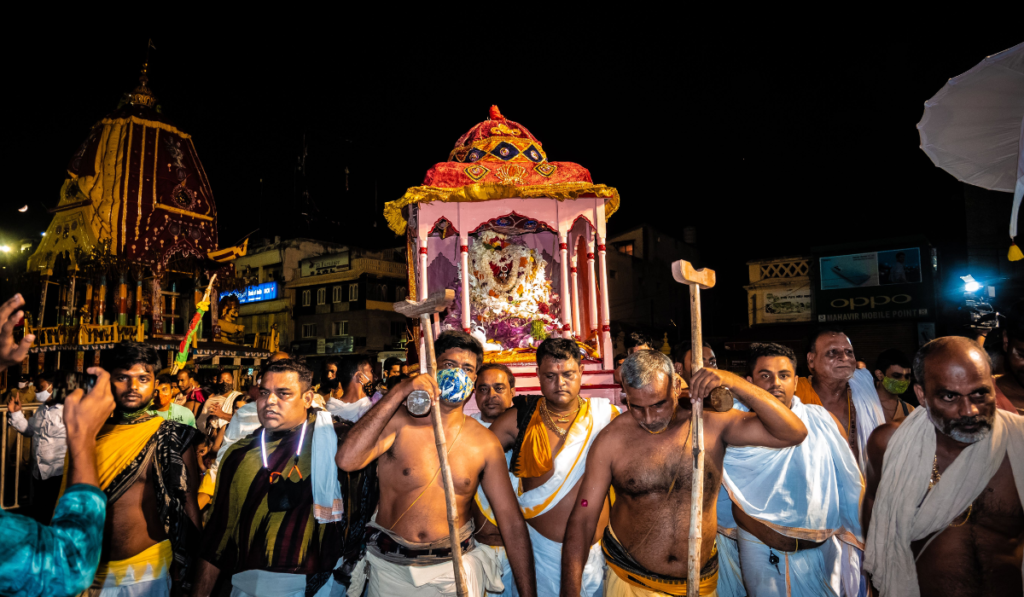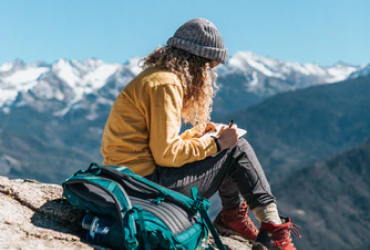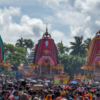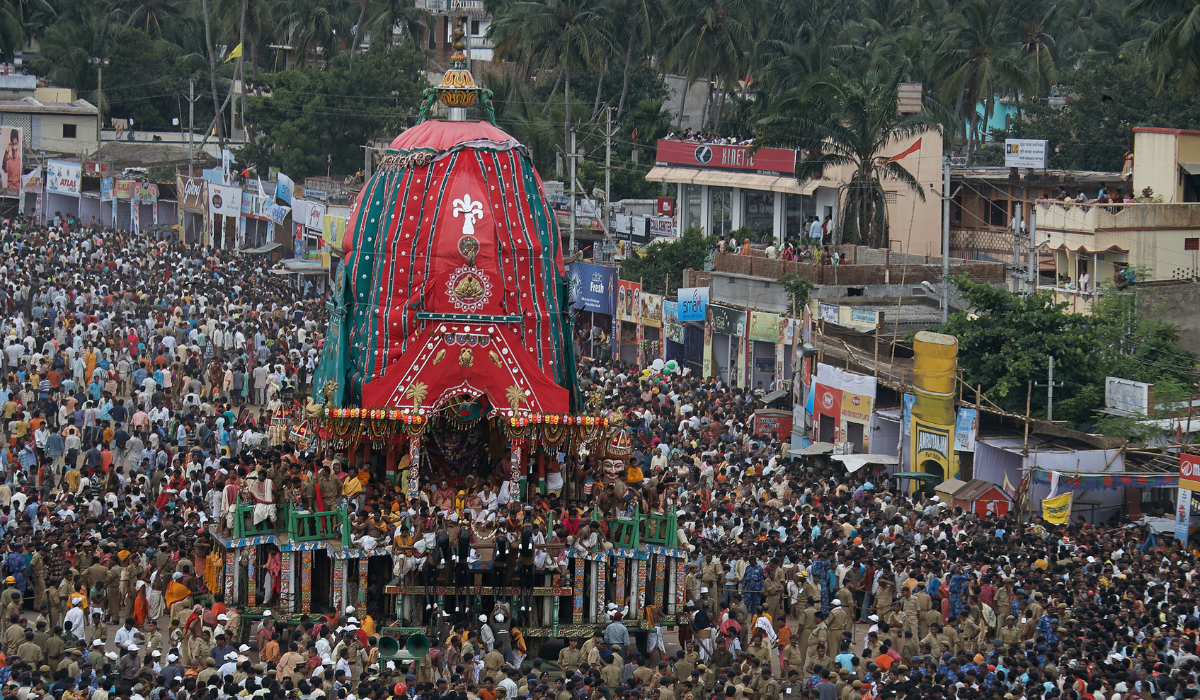The Rath Yatra initiates on the second lunar day, the bright fortnight of the Ashadha. Before the Rath Yatra, the Gundicha Temple is religiously cleansed to house the gods.
On the day of yatra, the deities are transported in chariots from the main temple to the Gundicha temple. This is Jagannath Puri’s renowned Rath Yatra, also known as the Chariot Festival. The multitudes of devotees assembled there pulled the three majestic chariots carrying the three deities. There are three chariots in the chariot procession: one for each deity, with the central chariot, the Nandighosha, carrying Jagannath, the principal deity; the second chariot, the Taladhwaja, carrying Balabhadra; and the third, the Darpadalana, carrying Subhadra. Before dusk falls, the procession travels the 3-kilometer “Bada Danda” (long avenue) to the Gundicha temple’s gates. On the first day, the gods stay in their chariots, and on the second, they go inside the Gundicha Temple. They spent the next seven days staying at the Gundicha temple.
There are some rituals of the Rath Yatra that are followed every year, including:
Worship
One unique aspect of the deity worship at Gundicha Temple is that the puja is performed by Brahmin temple slaves rather than by daitas, the customary non-Brahmin attendants of Jagannath who are not allowed to be worshiped. Even though devadasis often serve as Lakshmi’s agents, they worship in the same way at the Gundicha Temple as they do at the main temple, leaving Lakshmi in the main temple. This suggests a different background for the devadasis’s function in the Gundicha Temple. The idols also have an unusual feature: greater amounts of sandalwood paste are applied twice a day to the images as a “cooling agent” (as is frequently done to the goddess Gundicha). Every day, the deities are decorated with new dresses in the temple.
Nabakalebar
It is a ritual or a symbolic cycle of death and rebirth. This symbolic cycle is represented by replacing the old wooden idols with the new ones, and this happens every 8, 12, or 19 years.
Chhera Panhara
The Chhera Panhara is one of the most important Rath Yatra rites. The King of Puri, who is regarded as the Lord’s most important servant, conducts this rite. The monarch, representing equality and humility in the eyes of God, waters the chariots and sweeps them with a broom with a golden handle. The idea that all people are equal before Lord Jagannath, regardless of social status, is emphasized by this deed.

image courtesy: Times of India
Pulling the chariots
This is where the fun begins. Each chariot is coupled with four wooden horse idols, and the journey begins when the kahali is blown. The chariots are attached to four strong ropes made of coconut fiber that are eight inches in diameter and nearly 250 feet long.
Hera Panchami
This ritual happens at Gundicha Temple. Hera Panchmi is on the fifth day of the rath yatra. Hera means to see. During the reign of Gajapati Kapilendra Deb, the event underwent a makeover that increased its realism. He transformed this divine rite into a more humane ceremony and presented a gold idol of Mahalakshmi. Goddess Lakshmi departs from the Srimandira on this day and arrives in the Gundicha retreat to meet Shri Jagannath during the Sandhya Dhupa.
The legend goes like this: after recovering from the illness or Anasar period, Lord Jagannath tells Goddess Laxmi that he looks forward to changing the place and expresses his desire to visit the Gundicha temple. Devi Lakshmi had seen her husband recovering from the illness; she agreed to the proposal but suggested Lord take someone along.
Jagannath conveyed that he would take along Dau Baladev and his sister Subhadra, as they were ill too and needed a change. Jagannath appears to have forgotten that he left his wife back at Srimandira when he arrived at the Gundicha temple. He had assured Mahalakshmi when he left the Srimandira that he would return in a day, but oddly, he had been gone from his temple for about five days since the day of the Ratha Yatra.
His untold absence makes Mahalakshmi restless. She gets angry by the careless attitude of the Lord and calls on Gundicha Temple to find out regarding the Lord Jagannath’s wellbeing and also to initiate his early return to Srimandira. On this occasion, an annoyed Goddess Laxmi, after consulting Bimala Devi and Bhu Devi in the form of Subarna Mahalakshmi, arrived at Gundicha temple in a decorated palanquin with her servitors. While leaving the Srimandir, Goddess Bimala shares a portion of Moha Churna, powered by Tantrik rituals. Goddess Bimala gives Goddess Mahalakshmi and is instructed to secretly apply the Moha Churna to Shri Jagannath in an effort to draw him to her and return him as soon as possible to the Srimandira.
Now, the priests at Gundicha Temple take her inside the temple for an audience with Lord Jagannath. Both Lord Jagannath and Goddess Mahalakshi are made to sit face-to-face in the sanctum of the Gundicha. Goddess Lakshmi gives Lord Jagannath the Moha Churna and begs him to come back to Srimandir. Jagannath agrees. By presenting Mahalakshmi with the Agyan Mala, or consent garland, he gives her permission to return, which she accepts, and he departs for Srimandir.

image courtesy: hera panchami
Ratha Bhanga
Goddess Lakshmi leaves the Gundicha temple because she is dissatisfied with Lord Jagannath’s carefree attitude. She is given a hurried send-off, and the Gundicha temple doors are quickly closed when Shri Jagannath gives her the consent garland. Her indignation is heightened by this furious act.
She commands her servants to inflict harm on a section of Lord Jagannath’s chariot, Nandighosa, as a way to express her rage for being abandoned and separated. The Ratha Bhanga is the name of this ritual of shattering chariots. Goddess Lakshmi hides behind a tamarind tree outside the Gundicha temple during this attempt to damage the chariot. She watches her attendants smash the chariot while hiding. Afterwards, she leaves through Heragohari Sahi Lane, an exclusive hallway, rather than taking the Bada Danda, the main route that leads back to the temple.
Dakshina Moda
The Dakshan Moda one day after Hera Panchami, on the sixth day, the chariots are turned over in a ceremony. Lord Jagannath detects Lakshmi’s rage, and the Triad’s departure process starts at the Gundicha temple. The chariots that were stationed in front of the Gundicha temple were dragged to the south and turned to face the Srimandira. All three of the chariots will stand near the Nakachana Dwara, the eastern. During the Bahuda Yatra-Return chariot celebration, the gods would climb on their chariots through this gate and then depart from the Gundicha temple.

image courtesy: odishabytes
Raas Leela
The Dakshin Moda ceremony also initiates the Rasa Lila of Lord Jagannath, which continues for three days at the Gupta Vrindavan in Gundicha temple. During the Lord Jagannath stopover at the Gundicha, the Vaishnavas consider the Gundicha temple as Vrindavan. All through Anabasara, Shri Hari is engaged in the Madura Rasa Krida. These fifteen days he spends with his wives, showering his love on his beloved consorts in Swakriya-Rasa. Swakriya-Rasa discusses the marriages of Shri Jagannath and his consorts, as well as the marriages of Shri Krishna and his consorts at Dwarka. After the fifteen days of seclusion with Goddess Lakshmi, Parakiya-Rasa with Shri Radha and the Gopis of Vrindavan is what Shri Jagannath wants. Since both Shri Radha and Shri Lakshmi are the same, Lord Jagannath is aware that they cannot coexist. His true intention for Raas Leela is still hidden, but his love for both of them endures since they both stand for devotion and love for that one Lord.
Conclusion
Any festival’s significance is mostly determined by the populace’s level of religion. Owing to the absence of prescriptive principles in our society, individuals with diverse backgrounds might identify a certain ritual in a variety of ways. Some people may believe that the purpose of the Ratha Yatra is just for Lord Jagannath to accompany his siblings on their yearly vacation, while others believe that the Lord wants to come down to Earth to oversee the welfare of his people and country. And to others, He may be the Absolute Soul, being outside of space and time and advocating for tolerance and social acceptance. He may also be the ideal man, seeing no distinction between caste, creed, or cultural intolerance because all are equal in his eyes.
Lord Jagannath is the Lord of the Universe. His compassion is evident in the myriad legends and rituals associated with his worship. Lord Jagannath is often depicted as a deity who shares an intimate bond with his followers, experiencing their joys and sorrows as his own. This divine empathy is beautifully illustrated in the stories where he takes on the suffering of his devotees, such as the tale of Madhavdas, where Lord Jagannath is said to have absorbed Madhavdas’s fever to relieve him from illness. Lord Jagannath’s care extends beyond miracles; it encompasses the daily rituals, festivals, and the very design of his temple, fostering a profound sense of belonging and reassurance among his followers that they are always under his benevolent protection.
Let’s stay connected! Come say hi on Instagram or follow us on Facebook for daily inspo.
CATEGORIES

DIY
10 Post(s)

Fashion
3 Post(s)

Food
2 Post(s)

Health
4 Post(s)

Home Sweet Home
4 Post(s)
Spritual Pathways
3 Post(s)







